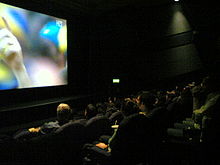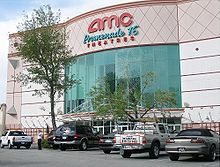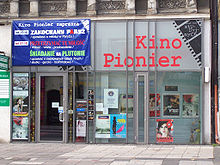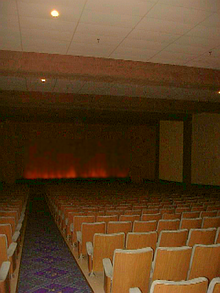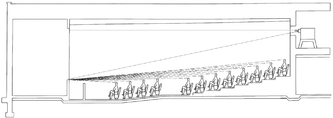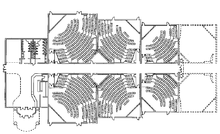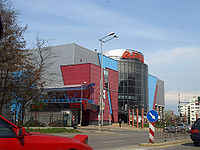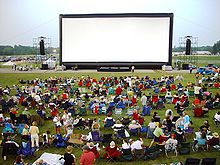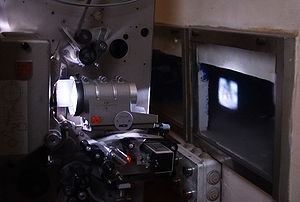- Movie theater
-


A cinema in Australia A movie theater, cinema, movie house, picture theater, film theater is a venue, usually a building, for viewing motion pictures ("movies" or "films").
Most but not all movie theaters are commercial operations catering to the general public, who attend by purchasing a ticket. The movie is projected with a movie projector onto a large projection screen at the front of the auditorium. Some movie theaters are now equipped for digital cinema projection, removing the need to create and transport a physical film print.
Contents
Spelling and alternative terms
Outside of North America, most English-speaking countries use the term cinema (
 /ˈsɪnɨmə/), formerly spelt "kinema"[citation needed] (/ˈkɪnɨmə/). Both terms, as well as their derivative adjectives "cinematic" and "kinematic," ultimately derive from the Greek κινῆμα, -ατος, "movement." In these areas the term "theatre" is usually restricted to live-performance venues.
/ˈsɪnɨmə/), formerly spelt "kinema"[citation needed] (/ˈkɪnɨmə/). Both terms, as well as their derivative adjectives "cinematic" and "kinematic," ultimately derive from the Greek κινῆμα, -ατος, "movement." In these areas the term "theatre" is usually restricted to live-performance venues.In the United States, the customary spelling is "theater", but the National Association of Theatre Owners uses the spelling "theatre" to refer to a movie theater.
Colloquial expressions, mostly used for cinemas collectively, include the silver screen, the big screen (contrasted with the "small screen" of television) and (in the United Kingdom) the pictures, the flicks, and the flea pit (or fleapit).
A "screening room" usually refers to a small facility for viewing movies, often for the use of those involved in the production of motion pictures, or in large private residences.
History in the US
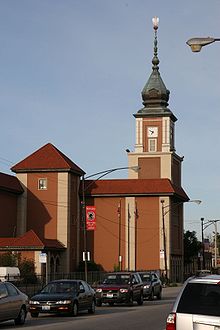 The Gateway Theatre in Jefferson Park, Chicago was a Movie palace for the Balaban and Katz theater chain. The theater's Baroque spire is a replica of the Royal Castle in Warsaw.
The Gateway Theatre in Jefferson Park, Chicago was a Movie palace for the Balaban and Katz theater chain. The theater's Baroque spire is a replica of the Royal Castle in Warsaw.
Before 1900
The first public exhibition of projected motion pictures in the United States was at Koster and Bial's Music Hall on 34th Street in New York City on April 23, 1896[citation needed]. However, the first "storefront theater" in the US dedicated exclusively to showing motion pictures was Vitascope Hall, established on Canal Street, New Orleans, Louisiana June 26, 1896—it was converted from a vacant store.
A crucial factor was Thomas Edison's decision to sell a small number of Vitascope Projectors as a business venture in April–May 1896. In the basement of the new Ellicott Square Building, Main Street, Buffalo, New York, Mitchell Mark (properly spelled Mitchel Mark) and his brother Moe Mark added what they called Edison’s Vitascope Theater (entered through Edisonia Hall), which they opened to the general public on October 19, 1896 in collaboration with Rudolf Wagner, who had moved to Buffalo after spending several years working at the Edison laboratories. This 72-seat plush theater was designed from scratch solely to show motion pictures.
Terry Ramseye, in his book, A Million and One Nights (1926) [p. 276], notes that this “was one of the earliest permanently located and exclusively motion-picture exhibitions.” According to the Buffalo News (Wednesday, November 2, 1932), "There were seats for about 90 persons and the admission was three cents. Feeble, flickering films of travel scenes were the usual fare." (The true number of seats was 72.) The theater remained open for two years making it the first permanent, purpose built movie theater in the world.
 This November 7, 1897 ad shows the actual programming of Vitascope Theater, one of the first motion picture theaters specially built for that purpose. In its first year, 200,000 people attended. It was in Buffalo, New York. However, during the rest of this period, between 1891–1900, films did not achieve much popularity.[1]
This November 7, 1897 ad shows the actual programming of Vitascope Theater, one of the first motion picture theaters specially built for that purpose. In its first year, 200,000 people attended. It was in Buffalo, New York. However, during the rest of this period, between 1891–1900, films did not achieve much popularity.[1] Many older movie theaters, such as the River Oaks Theatre in Houston, Texas, have been restored and play arthouse movies; newer multiplexes in the areas with restored theaters show first run films.
Many older movie theaters, such as the River Oaks Theatre in Houston, Texas, have been restored and play arthouse movies; newer multiplexes in the areas with restored theaters show first run films. Other older movie theaters, such as the Texas Theatre in Dallas, Texas, have been deemed historically significant and undergone restoration. The Texas Theater is shown here in 2008 with replica marquee and appears as it did in 1963 when Lee Harvey Oswald was arrested on the premises. The building today hosts live theater.
Other older movie theaters, such as the Texas Theatre in Dallas, Texas, have been deemed historically significant and undergone restoration. The Texas Theater is shown here in 2008 with replica marquee and appears as it did in 1963 when Lee Harvey Oswald was arrested on the premises. The building today hosts live theater.
1900–1919
The first permanent structure designed for screening of movies in the state of California was Tally's Electric Theater, completed in 1902 in Los Angeles. Tally's theater was a storefront within a larger building, but apparently purpose-built as a movie theater. The Great Train Robbery (1903), which was 12 minutes in length, would also give the film industry a boost.[2]
In 1905, Pittsburgh movie theater owners Harry Davis and John Harris also established the first of what would become a popular form of movie theaters spread throughout the country, which were five-cent nickelodeon movies. In 1906, Montreal opened one of the first movie theatres in the world. An even older movie theatre -which is still in action today, according to the Guinness World Records- belonged to the Pionier Cinema, and opened as the Helios on September 26, 1909, in Szczecin, Poland (at the time of the opening it was Stettin, Germany).[3] Nevertheless, this position was beaten in 2008 when the owners of the Korsør Biograf Teater in Korsør, Denmark, discovered that they actually operated a movie theater that opened in August 1908. They were accepted into the Guinness Book of World Records as the oldest still operating movie theater the same year (to appear in the 2010 edition of the book).[4]
In 1912, the Picture House, in Clevedon, England, opened with a charity film performance to raise funds for the victims of the Titanic disaster, and has been showing films continuously since. The 1913 opening of the Regent Theater in New York City signaled a new respectability for the medium, and the start of the two-decade heyday of American cinema design. The million dollar Mark Strand Theater at 47th Street and Broadway in New York City opened in 1914 by Mitchell Mark was the archetypical movie palace. The ornate Al Ringling Theater was the very first "Movie Palace" it was built in Baraboo, WI by Al Ringling, one of the founders of the Ringling Bros. Circus for the then incredible sum of $100,000.00. In 1915, the movie The Birth of a Nation would also pave way for feature films.[5] By 1915, feature films were so successful that the five cent ticket admission prices would expand to ten cents, hence ending the era of nickelodeon movie theaters.[6] Later, Los Angeles promoter Sid Grauman continued the trend of theatre-as-destination with his ornate "Million Dollar Theatre", using the same design firm as Ringling (the MDT was the first to signify its primary use for motion pictures with the "theatre" spelling), and opened on Broadway in downtown Los Angeles in 1918.
Post 1920s: modern era
In the next ten years, as movie revenues exploded, independent promoters and movie studios (who owned their own proprietary chains until an antitrust ruling in 1948) raced to build the most lavish, elaborate, attractive theatres. These forms morphed into a unique architectural genre—the movie palace—a unique and extreme architectural genre which boasted a luxurious design, a giant screen, and, beginning in 1953, stereophonic sound. The movie chains were also among the first industries to install air conditioning systems which gave the theatres an additional lure of comfort in the summer period. In addition in the early 1931 a chair was designed, where the person sitting could move back so other patrons could easily leave their seats during the movie showing. This type of seat became standard in almost all US movie theaters.[7]
Several movie studios achieved vertical integration by acquiring and constructing theatre chains. The so-called "Big Five" theatre chains of the 1920s and 1930s were all owned by studios: Paramount, Warner, Loews (which owned Metro-Goldwyn-Mayer), Fox, and RKO. All were broken up as a result of the U.S. Supreme Court's ruling in the 1948 United States v. Paramount Pictures, Inc. anti-trust case.
In the 1970s, porn theatres became ubiquitous in some areas. However, the introduction of the low-cost VHS video system for home televisions has decommissioned many porno cinemas as well as many 'second-run' theatres.
People can pay to watch movies at home after a few short months following their theatrical release, through cable television or streaming media: pay-per-view (PPV) and video on demand (VOD). Initially, home video contributed to an industry wide slump in the late 1980s (see disruptive technology), not to mention the decline of the 'Dollar Cinema' (where first-run films are pulled from circulation to play at reduced rates for the remainder of their run). The theater industry responded by building larger auditoriums with stadium seating layouts, installing more screens (to allow for more variety and more show times), upgrading sound systems and installing more amenities and higher-quality food and drink. The growing popularity of high-definition television sets, along with HD DVD and Blu-ray Disc players may also contribute to the decline in cinema attendance, although there seems to be little evidence of this at the moment. As of June 12, 2009 all US television stations started broadcasting in the digital format. This could also affect US movie theaters.[citation needed]
3D
3-D film is a system of presenting film images so that they appear to the viewer to be three-dimensional. Visitors usually borrow or keep special glasses to wear while watching the film. Depending on the system used, these are typically polarized glasses. Three-dimensional films use two images channelled, respectively, to the right and left eyes to simulate depth by using 3-D glasses with red and blue lenses (anaglyph), polarized (linear and circular), and other techniques. 3-D glasses deliver the proper image to the proper eye and make the image appear to "pop-out" at the viewer and even follow the viewer when he/she moves so viewers relatively see the same image. Most 3-D films are shown in amusement parks and even "4-D" techniques are used when certain effects such as spraying of water, movement of seats, and other effects are used to simulate actions seen on the screen. The earliest 3-D films were presented in the 1920s. There have been several "waves" of 3D film distribution, most notably in the 1950s when they were promoted as a way to offer audiences something that they could not see at home on television. Still the process faded quickly and as yet has never been more than a periodic novelty in film presentation. Currently, films are again being presented in cinemas in 3-D, in the IMAX 3D system and in digital 3-D, such as is used in the animated films of Disney/Pixar.
In 2009, Ben Walters suggested that film exhibitors are now more interested in 3-D film. The number of 3-D screens in theaters is increasing (Real D company expects 15,000 screens worldwide in 2010). 3-D films encourage exhibitors to adopt digital cinema and provide a way to compete with home theaters. One incentive for 3-D screens is that although ticket sales decline, revenues from 3-D tickets grow.[8]
The RealD 3D system works by using a single digital projector, that swaps back and forth between the images for each eye. A filter is placed in front of the projector that changes the polarisation of the light coming from the projector. A silver screen is used to reflect this light back at the audience and reduce loss of brightness. RealD is the most popular system, but there are three other systems available: Master Image, XpanD and Dolby 3D.
When a system is used that requires inexpensive 3D glasses, they can sometimes be kept by the visitor. In most theaters the price is not simply for the glasses, but for the experience of 3D. Most theatres have a fixed cost for 3D, while others charge for the glasses, but the latter is uncommon (at least in the United States). For example, in Pathé theaters in the Netherlands the extra fee for watching a 3D film consists of a fixed fee of € 1.50, and an optional fee of €1 for the glasses.[9] Holders of the Pathé Unlimited Gold pass (see also below) are supposed to bring along their own glasses; one pair, supplied yearly, more robust than the regular type, is included in the price.
IMAX
IMAX is a system using film with more than ten times the frame size of a 35 mm film to produce image quality far superior to conventional film. IMAX theaters use an oversized screen as well as special projectors. Invented by a Canadian company, the first permanent IMAX theater was at Ontario Place in Toronto, Ontario, Canada.
At the IMAX cinema attached to the National Media Museum in Bradford, West Yorkshire, England, in the United Kingdom, visitors to the museum's sixth floor can observe the IMAX projection booth via a glass rear wall, and watch the large format films being loaded and projected.[10]
Design
 Interior of Hoyts Southbank cinemas in Australia, with stadium seating, acoustic wall hangings, wall-mounted speakers, and cup holders
Interior of Hoyts Southbank cinemas in Australia, with stadium seating, acoustic wall hangings, wall-mounted speakers, and cup holders
Traditionally a movie theater, like a stage theatre, consists of a single auditorium with rows of comfortable seats, as well as a foyer area containing a box office for buying tickets, a counter and/or self-service facilities for buying snacks and drinks, and washrooms. Stage theaters are sometimes converted into movie theatres by placing a screen in front of the stage and adding a projector; this conversion may be permanent, or temporary for purposes such as showing arthouse fare to an audience accustomed to plays. The familiar characteristics of relatively low admission and open seating can be traced to Samuel Roxy Rothafel, an early movie theater impresario. Many of these early theatres contain a balcony, an elevated level across the auditorium above the theater's rearmost seats. The rearward main floor "loge" seats were sometimes larger, softer, and more widely spaced and sold for a higher price.
In conventional low pitch viewing floors the preferred seating arrangement is to use staggered rows. While a less efficient use of floor space this allows a somewhat improved sight line between the patrons seated in the next row toward the screen, provided they do not lean toward one another.
"Stadium seating", popular in modern multiplexes, actually dates back to the 1920s. The 1922 Princess Theatre in Honolulu, Hawaii featured "stadium seating," sharply raked rows of seats extending from in front of the screen back towards the ceiling. It gives patrons a clear sight line over the heads of those seated in front of them. Modern "stadium seating" was utilized in IMAX theatres, which have very tall screens, beginning in the early 1970s.
Rows of seats are divided by one or more aisles so that there are seldom more than 20 seats in a row. This allows easier access to seating, as the space between rows is very narrow. Depending on the angle of rake of the seats, the aisles have steps. In older theaters, aisle lights were often built into the end seats of each row to help patrons find their way in the dark. Since the advent of stadium theaters with stepped aisles, each step in the aisles may be outlined with small lights to prevent patrons from tripping in the darkened theater.
Theaters often have booster seats for children and other short people to put on the seat, to sit higher, for a better view.
See also luxury screens below.
Multiplexes and megaplexes
Canada was the first country in the world to have a two-screen theater. The Elgin Theatre in Ottawa became the first venue to offer two film programs on different screens in 1957 when Canadian theater-owner Nat Taylor converted the dual screen theater into one capable of showing two different films simultaneously.
Taylor is credited by Canadian sources as the inventor of the multiplex or cineplex; he later founded the Cineplex Odeon Corporation, opening the 18-screen Toronto Eaton Centre Cineplex, the world's largest at the time, in Toronto, Canada.[1]
In the United States, Stanley Durwood of American Multi-Cinema (now AMC Theatres) is credited as pioneering the multiplex in 1963 after realizing that he could operate several attached auditoriums with the same staff needed for one through careful management of the start times for each movie. Ward Parkway Center in Kansas City, Missouri had the first multiplex cinema in the United States.
Since the 1960s, multiple-screen theatres have become the norm, and many existing venues have been retrofitted so that they have multiple auditoriums. A single foyer area is shared among them. In the 1970s many large 1920s movie palaces were converted into multiple screen venues by dividing their large auditoriums, and sometimes even the stage space, into smaller theaters.
In most markets, nearly all single-screen theatres (sometimes referred to as a "Uniplex") have gone out of business; the ones remaining are generally used for arthouse films, e.g. the Crest Theatre [2] in downtown Sacramento, California, small scale productions, film festivals or other presentations. Because of the late development of multiplexes, the term "cinema" or "theater" may refer either to the whole complex or a single auditorium, and sometimes "screen" is used to refer to an auditorium.
A popular film may be shown on multiple screens at the same multiplex, which reduces the choice of other films but offers more choice of viewing times or a greater number of seats to accommodate patrons. Two or three screens may be created by dividing up an existing cinema (as Durwood did with his Roxy in 1964), but newly built multiplexes usually have at least six to eight screens, and often as many as twelve, fourteen or even sixteen.
Although definitions vary, a large multiplex with 20 or more screens is usually called a megaplex however in the United Kingdom this was a brand name for large Virgin Cinema (later UGC). The first megaplex is generally considered to be the Kinepolis in Brussels, Belgium, which opened in 1988 with 25 screens and a seating capacity of 7,500. The first theatre in the U.S. built from the ground up as a megaplex was the AMC Grand 24 in Dallas, Texas, which opened in May 1995, while the first megaplex in the U.S. based on an expansion of an existing facility was Studio 28 in Grand Rapids, Michigan, which reopened in November 1988 with 20 screens and a seating capacity of 6,000.
Drive-in
A drive-in movie theatre is basically an outdoor parking area with a screen – sometimes an inflatable screen – at one end and a projection booth at the other. Moviegoers drive into the parking spaces which are sometimes sloped upwards at the front to give a more direct view of the movie screen. Films are usually viewed through the car windscreen (windshield) although some people prefer to sit on the hood of the car. Sound is either provided through portable loudspeakers located by each parking space, or is broadcast on an FM radio frequency, to be played through the car's stereo system. Because of their outdoor nature, drive-ins usually only operate seasonally, and after sunset. Drive-in movie theatres are mainly found in the United States, where they were especially popular in the 1950s and 1960s. Once numbering in the thousands, about 400 remain in the U.S. today. In some cases, multiplex or megaplex theatres were built on the sites of former drive-in theatres.
Other venues
 1967 Bedford mobile cinema
1967 Bedford mobile cinema
Some outdoor movie theatres are just cleared areas where the audience sits upon chairs or blankets and watch the movie on a temporary screen, or even the wall of a convenient building.
Colleges and universities have often sponsored film screenings in lecture halls. The formats of these screenings include 35 mm, 16 mm, DVD, VHS, and even 70 mm in rare cases.
Some alternative methods of showing films have been popular in the past. In the 1980s the introduction of VHS cassettes made possible video-salons, small rooms where visitors viewed the film on a large TV. These establishments were especially popular in the Soviet Union, where official distribution companies were slow to adapt to changing demand, and so movie theatres could not show popular Hollywood and Asian films.
In 1967 the British government launched seven custom built mobile cinema units for use as part of the Ministry of Technology campaign to raise standards. Using a very futuristic look these 27 seat cinema vehicles were designed to attract attention. They were built on a Bedford SB3 chassis with a custom Coventry Steel Caravan extruded aluminium body.
Films are also commonly shown on airliners in flight, using large screens in each cabin or smaller screens for each group of rows or each individual seat; the airline company sometimes charges a fee for the headphones needed to hear the films's sound. Films are sometimes also shown on trains, such as the Auto Train.
The smallest purpose-built cinema is the Cabiria Cine-Cafe which measures 24 m² (258.3 ft²) and has a seating capacity of 18. It was built by Renata Carneiro Agostinho da Silva (Brazil) in Brasilia DF, Brazil in 2008. It is mentioned in the Guinness Book of Records, January, 2010.
The Bell Museum of Natural History in Minneapolis, Minnesota has recently begun summer "bike-ins," inviting only pedestrians or people on bicycles onto the grounds for both live music and movies. In various Canadian cities, including Toronto, Calgary, Ottawa and Halifax, al-fresco movies projected on the walls of buildings or temporarily erected screens in parks operate during the Summer and cater to a pedestrian audience.
Programming
Movie theaters may be classified by the type of movies or when they are shown:
- First-run theater: A theater that runs primarily mainstream film fare from the major film companies and distributors, during the initial new release period of each film.
- Second-run or discount theater: A theater that runs films that have already shown in the first-run theaters and presented at a lower ticket price. (These are sometimes known as dollar theaters or "Cheap Seats".) This form of cinema is diminishing in viability owing to the increasingly shortened intervals before the films' home video release, called the video window.
- Repertoire/repertory theater or arthouse: A theater that presents more alternative and art films as well as second-run and classic films (often known as an "Independent Cinema" in the UK).
- An adult movie theater or sex theater specializes in showing pornographic movies. Such movies are rarely shown in other theaters. See also Golden Age of Porn.
- IMAX theaters can show conventional movies, but the major benefits of the IMAX system are only available when showing movies filmed using it. While a few mainstream feature films have been produced in IMAX, IMAX movies are often documentaries featuring spectacular natural scenery, and may be limited to the 45-minute length of a single reel of IMAX film.
Presentation
Usually an admission is for one feature film. Sometimes two feature films are sold as one admission (double feature), with a break in between. Separate admission for a short subject is rare; it is either an extra before a feature film or part of a series of short subjects sold as one admission (this mainly occurs at film festivals). (See also anthology film.)
Historically, many movie theatres presented a number of shorter items in addition to the feature film. This might include a newsreel, live-action comedy short films, documentary short films, musical short films, and/or cartoon shorts (many classic cartoons series such as the Looney Tunes and Mickey Mouse shorts were created for this purpose). Examples of this kind of programming are available on certain DVD releases of two of the most famous films starring Errol Flynn, Captain Blood and The Adventures of Robin Hood as a special feature arrangement designed to recreate that kind of filmgoing experience. Some theatres ran on continuous showings, where the same items would repeat throughout the day, with patrons arriving and departing at any time rather than having distinct entrance and exit cycles. Newsreels gradually became obsolete by the 1960s with the rise of television news, and most material now shown prior to a feature film is of a commercial or promotional nature.
A typical modern theatre presents commercial advertising shorts, then movie trailers, and then the feature film. Advertised start times are usually for the entire program or session, not the feature itself;[11] thus people who want to avoid commercials and/or trailers would opt to enter later. This is easiest and causes the least inconvenience when it is not crowded, and/or one is not very choosy about where one wants to sit. If one has a ticket for a specific seat (see below) one is formally assured of that, but it is still inconvenient and disturbing to find and claim it during the commercials and trailers, unless it is near an aisle.
Some movie theaters have some kind of break during the presentation. There may also be a break between the introductory material and the feature. Some countries such as the Netherlands have a tradition of incorporating an intermission in regular feature presentations, though many theaters have now abandoned that tradition,[12] while in North America, this is very rare and usually limited to special circumstances involving extremely long movies.
During the closing credits many people leave, but some stay until the end. Usually the lights are switched on after the credits, sometimes already during them. Some films show additional scenes while the credits are rolling.
Until the multiplex era, prior to showtime, the screen would typically be covered by the traditional curtain which would be drawn for the feature. It is common practice in Australia for the curtain to cover part of the screen during advertising and trailers, then be fully drawn to reveal the full width of the screen for the main feature. Some theaters, lacking a curtain, occupied the screen with slides of some form of abstract art. Currently, in multiplexes, theater chains often feature a continuous slideshow between showings featuring a loop of movie trivia, promotional material for the theater chains (such as encouraging patrons to purchase gift vouchers and group rates, or buy foyer retail offers), or advertising for local and national businesses. Advertisements for Fandango (for what???) and other convenient methods of purchasing tickets is often shown. Also prior to showing the film, reminders, in varying forms would be shown concerning theater etiquette (no smoking, no talking, no littering, removing crying babies, etc.) and in recent years, added reminders to silence mobile phones as well as concerning movie piracy.
Some well-equipped theaters have "interlock" projectors which allow two or more projectors and sound units to be run in unison by connecting them electronically or mechanically. This set up can be used to project two prints in sync (for dual-projector 3-D) or to "interlock" one or more sound tracks to a single film. Sound interlocks were used for stereophonic sound systems before the advent of magnetic film prints. Fantasound (developed by RCA in 1940 for Disney's Fantasia) was an early interlock system. Likewise, early stereophonic films such as This Is Cinerama and House of Wax utilized a separate, magnetic oxide-coated film to reproduce up to six or more tracks of stereophonic sound.
Datasat Digital Entertainment, purchaser of DTS's cinema division in May 2008, uses a time code printed on and read off of the film to synchronize with a CD-ROM in the sound track, allowing multi-channel soundtracks or foreign language tracks. This is not considered a projector interlock, however.
This practice is most common with so-called blockbuster movies. Muvico Theaters, Regal Entertainment Group, Pacific Theatres and AMC Theatres are some theatres that interlock films.[citation needed]
Live broadcasting to movie theaters
Sometimes movie theaters provide digital projection of a live broadcast of an opera, concert, or other performance or event. For example, there are regular live broadcasts to movie theaters of Metropolitan Opera performances, with additionally limited repeat showings.
Admission prices are often more than twice the regular movie theater admission prices.
Pricing and admission

In order to obtain admission to a movie theater, the prospective theater-goer must usually purchase a ticket, which may be for an arbitrary seat ("open" or "free" seating, first-come, first-served) or for a specific one (allocated seating).[14] Movie theaters in North America generally have open seating. Cinemas in Europe can have free seating or numbered seating. Some theatres in Mexico offer numbered seating, in particular, Cinepolis VIP. In the case of numbered seating systems the attendee can often pick seats from a screen; sometimes the attendee cannot see the screen and has to make a choice based on still available seats. In the case of free seats, already seated customers may be forced by staff to move one or more places for the benefit of an arriving couple or group wanting to sit together.
In 2010, the average price for a movie ticket in the United States was $7.89.[15]
The price of a ticket may be discounted during off-peak times e.g. for matinées, and higher at busy times, typically evenings and/or weekends. In Australia and Canada, when this practice is used, it is traditional to offer the lower prices for Tuesday for all showings, one of the slowest days of the week in the movie theatre business, which has led to the nickname "cheap Tuesday."[16] Sometimes tickets are cheaper on Monday, or on Sunday morning. Almost all movie theaters employ economic price discrimination: tickets for youth, students, and seniors are typically cheaper. Large theater chains, such as AMC Theaters, also own smaller theaters that show "second runs" of popular films, at reduced ticket prices. Movie theaters in India and other developing countries employ price discrimination in seating arrangement: seats closer to the screen cost less, while the ones farthest from the screen cost more.
In the United States, many movie theater chains sell discounted passes, which can be exchanged for tickets to regular showings. These passes are traditionally sold in bulk to institutional customers and also to the general public.[17][18] Some passes provide substantial discounts from the price of regular admission, especially if they carry restrictions. Common restrictions include a waiting period after a movie's release before the pass can be exchanged for a ticket or specific theaters where a pass is ineligible for admission.
Some movie theaters and chains sell monthly passes for unlimited entrance to regular showings. Even if the price is quoted per month the minimum duration may be several months, and when subscribing again after termination a one-time extra fee may be charged. Some examples:
- Pathé Unlimited Card (PUC) for the chain of 16 multi- and megaplex theatres of Pathé in the Netherlands (129 screens), for €19/month.
- Pathé Unlimited Gold for the same movie theaters, but including 3D and IMAX, for €26/month.
- Cineville Pass for 13 Amsterdam movie theaters (almost all movie theaters except those of Pathé) for € 17.50 per month.
- Groninger Filmkaart for €20/month for the two movie theaters MustSee Euroborg (10 screens) and Images (3 screens) in Groningen.
- Must See All Card for €18/month for movie theater MustSee Euroborg only.
- Unlimited Card for the chain of movie theaters of Cineworld (formerly UGC) in the UK and Ireland, for £14.99/month, or £17.99 including those in London's West End (plus £1.50 per 3D film viewed) – tickets can only be purchased on the day of the showing.
- Carte Le Pass for the chain of movie theatres of Pathé/Gaumont in 40 French cities (with a total of 790 screens), for 19.80 euro/month.
- UGC Illimité passes for all UGC movie theaters in France, for 18 euro/month, and an entrance fee of 30 euro.
- UGC Unlimited passes for the four UGC movie theaters in Belgium, for 15 euro/month.
- SF Movie Passport pass for all the movies shown in SF Group theaters in Thailand, valid for a month for one person and one showing per movie, at the price of 800 baht or eqv USD 20.
- Membresía Club Cinépolis $125 Pesos(10USD)/month for the regular membership grants access to all the facilities across México for unlimited viewing. 1 Year of forced membership is required. There are also VIP and double memberships.
- Hotlips adult movie theater The Hague, for 55 euro/month.
Note that in Thailand there is the restriction of one viewing per movie, while in the Netherlands one can see any movie as many times as one wants as is the case with the Cineworld UK pass.
The increasing number of 3D films, for which a fee is required, somewhat undermines the concept of unlimited entrance to regular showings, in particular if no 2D version is screened, except in the cases where 3D is included. Also, in one Pathé theater in the Netherlands on one day of the week buying a drink and a snack is compulsory.
Some adult theaters sell a day pass, either as standard ticket, or as an option that costs a little more than a single admission.
Also for some film festivals a pass is sold for unlimited entrance.
Luxury screens
Cinemas in city centers are increasingly offering luxury seating with services like complimentary refills of soft drinks and popcorn, a bar, reclining leather seats and service bells. The Vue Cinema chain is a good example of a large-scale offering of such a service, called "Gold Class" and similarly Britain's largest cinema chain ODEON have gallery areas in some of their bigger cinemas where there is a separate foyer area with a bar and unlimited snacks.
Age restrictions
Admission to a movie may also be restricted by a motion picture rating system. According to such systems, children or teenagers below a certain age may be forbidden access to theaters showing certain movies, or only admitted when accompanied by a parent or other adult. In some jurisdictions a rating may legally impose this on movie theaters. Furthermore, where movie theaters do not have this legal obligation, they may enforce restrictions on their own.
Accordingly, a movie theater may either not be allowed to program an unrated film, or voluntarily refrain from that. In the US many mainstream movie theaters do not even show movies rated NC-17 ("No one 17 and under admitted"). Often, instead, an edited R-rated version ("Restricted. Persons under 17 are not admitted unless accompanied by parent or adult guardian.") is shown.[dubious ]
Revenue
Movie studios/film distributors in the U.S. traditionally drive hard bargains entitling them to as much as 100% of the gross ticket revenue during the first weeks (and then the balance changes in 10% increments at an undetermined time).[19] See also box office.
Ticket price uniformity
The relatively strong uniformity of movie ticket prices, particularly in the U.S., is a common economics puzzle, because conventional supply and demand theory would suggest higher prices for more popular movies, and vice versa. Unlike seemingly similar forms of entertainment such as rock concerts, every movie is a unique product. Demand is very difficult to predict ahead of time, and is usually determined from ticket sale statistics after the movie is already out. Uniform pricing is therefore a strategy to cope with unpredictable demand. Historical and cultural factors are sometimes also cited.[20]
Ticket check
In some movie theater complexes, the theaters are arranged such that tickets are checked at the entrance into the entire plaza, rather than before each theater.
At a theater with a sold-out show there is often an additional ticket check, to make sure that everybody with a ticket for that show can find a seat.
The lobby may be before or after the ticket check.
Movie theater culture in USA
Movie theaters are associated with dating, popcorn and expensive treats.
Intimacy
Sometimes couples go to a movie theater for the additional reason that it provides the possibility of intimacy, where the dark provides some privacy (with additional privacy in the back-row). This kind of intimacy is considered by some a lesser form of public display of affection. Compared with being together in a room without other people, it may also be reassuring for one or both of the couple (and for parents) that the intimacy is necessarily limited.
Arm rests pose a hindrance to intimacy for some people. Some theaters have love seats: seats for two without an armrest in the middle. The most modern theaters have movable armrests throughout the theater that when down can hold a food container as well as act as an armrest or partition between the seats and when up allow closer contact between the couple. Some theaters such as the Parkway in Oakland, California have sofas for greater comfort.[21]
Foyer area, food and drinks
Movie theaters usually sell various snack foods and drinks at retail counters or kiosks. Sometimes it can be a self-service where one pays at the counter till, and/or a coin-operated machines. Sometimes the area of sale is more like a self-service shop or kiosk (it is not suitable for consuming the goods), and one pays at the check-out between the shop and the area with the screens. Foods usually served at movie theatres include popcorn, soft drinks, nachos, hot dogs, ice creams and a wide range of confectionery. At most theatres, people are allowed to select their own sweets (known as "pick and mix".)
The facilities for buying snacks and drinks often represent the theater's primary source of profit since most of the ticket revenue goes to the film distributor (and onward to the movie studio)[citation needed]. Some movie theaters forbid eating and drinking inside the viewing room (restricting such activities to the foyer), while others encourage it by fitting cup holders on the arm rests (on the front side of the arm rests of one's own chair, or the back side of the arm rests in front) and selling large portions of popcorn and soft drinks; also in that case bringing one's own food and drinks may be forbidden. Retail is currently a huge area of expansion with many companies in the U.S. offering a wider range of snacks, including hot dogs and nachos.
Many theaters have embraced the "brew and view" concept, serving alcoholic beverages, in addition to snacks and popcorn. Some movie theaters such as the Alamo Drafthouse offer full restaurant service at one's seat, though this is not as widespread. McMenamins is a chain of restaurant/brewpub establishments in the U.S. states of Oregon and Washington, many of which have full movie theaters.
Some movie theaters feature a wider selection than simply snacks and popcorn. These "dine-in" theaters allow patrons to purchase "meals" (ranging from pizza slices to hamburgers and more) that can be consumed while watching the movie.
The health benefits of this cinema food are generally low, and have been debated for years. Owner of Sony Pictures, Michael Lynton, has been one of the chief arguers over this, and has wanted cinemas worldwide to stop providing this junk food and instead provide healthier alternatives, like crudites, smoothies, nuts, granola bars and additive-free air-popped popcorn.
Altercations
Due to the movie price ranges today and the expectation of comfort and calmness in a theater setting, theaters are commonly a venue to fights during the movie. Patrons are typically angered by cellphone use, talking, and other disturbances during the viewing.
For example, a film had to be stopped short at the Regal Stadium 14 in Bowie, MD due to a fight that occurred over a teenager who constantly put her feet on the chair of a child sitting in front of her. The father of the child had to be escorted out of the theater by local police.[22]
In February 2011, after a screening of Black Swan in Latvia, a man was shot dead for reportedly eating his popcorn too loudly.[23]
Business practice controversies
- Advertising – Many filmgoers complain about commercial advertising shorts, arguing that their absence would be one of the main advantages of going to a movie theater. Other critics such as Roger Ebert have expressed concerns that these advertisements, plus an excessive number of movie trailers, could lead to pressure to restrict the preferred length of the feature films themselves to facilitate playing schedules. So far, the theatre companies have typically been highly resistant to these complaints, citing the need for the supplementary income. Some chains like Famous Players and AMC Theatres have compromised with the commercials restricted to being shown before the scheduled start time for the trailers and the feature film. Individual theaters within a chain also sometimes adopt this policy.
- Presentation – Another major recent concern is that the dramatic improvements in stereo sound systems have led to cinemas playing the soundtracks of presented films at unacceptably high volume levels. Usually, the trailers are presented at a very high sound level, presumably to overcome the sounds of a busy crowd. The sound is not adjusted downward for a sparsely occupied theater, and some patrons employ earplugs for the trailer period. Volume is normally adjusted based on the projectionist's judgment of a high or low attendance. The film is usually shown at a lower volume level than the trailers. In response to audience complaints, a manager at a Cinemark theater in California explained that the studios set trailer sound levels, not the theater.
- Piracy – In recent years, cinemas have started to show warnings, before the movie starts, against using cameras and camcorders during the movie (camming). These warnings threaten customers with being removed from the cinema and arrested by the police. This example was shown at cinemas in the United Kingdom:
-
- You are not permitted to use any camera or recording equipment in this cinema. This will be treated as an attempt to breach copyright. Any person doing so can be ejected and such articles may be confiscated by the police. We ask the audience to be vigilant against any such activity and report any matters arousing suspicion to cinema staff. Thank you.
- Some theaters (including those with IMAX stadiums) have detectors at the doors to pick up recording smugglers. At particularly anticipated showings, theatres may employ night vision equipment to detect a working camera during a screening. In some jurisdictions this is illegal unless the practice has been announced to the public in advance.
- Crowd control – As movie theaters have grown into multiplexes and megaplexes, crowd control has become a major concern. An overcrowded megaplex can be rather unpleasant, and in an emergency can be extremely dangerous (indeed, "shouting fire in a crowded theater" is the standard example in American English of how to cause unnecessary panic). Therefore, all major theater chains have implemented crowd control measures. The most well-known measure is the ubiquitous holdout line which prevents ticket holders for the next showing of that weekend's most popular movie from entering the building until their particular auditorium has been cleared out and cleaned. Since the 1980s, some theater chains (especially AMC Theatres) have developed a policy of co-locating their theaters in shopping centers (as opposed to the old practice of building stand-alone theaters). They deliberately build lobbies and corridors that cannot hold as many people as the auditoriums, thus making holdout lines necessary. In turn, ticket holders may be enticed to shop or eat while stuck outside in the holdout line. However, given the fact that rent is based on floor area, the practice of having a smaller lobby is somewhat understandable.
- Refunds – Most cinema companies issue refunds if there is a technical fault such as a black out that stops people from seeing a movie. Refunds may be offered during the initial minutes of the screening, if an audience member changes their mind or does not like the movie.
Movie theaters and chains
Main article: List of cinema and movie theater chainsSee also
- British Board of Film Classification
- Film
- Film screening
- Fictional film
- Home cinema
- Inflatable movie screen
- List of film formats
- Motion Picture Association of America
- Movie palace
- Multiplex movie theater
- Nickelodeon movie theater
- Surround sound and THX
References
- ^ Vitascope Hall
- ^ Millard, Andre (1993). "Review: Before the Nickelodeon: Edwin S. Porter and the Edison Manufacturing Company by Charles Musser". Technology and Culture 34 (1): 166–167. JSTOR 3106478.
- ^ http://www.kino-pionier.com.pl/certy.html
- ^ World's oldest cinema is Danish,jp.dk, August 6th, 2008
- ^ MJ Movie Reviews – Birth of a Nation, The (1915) by Dan DeVore
- ^ The Nickelodeon's history
- ^ "Theater Chair Has Adjustable Back", March 1931, Popular Science bottom of page 34
- ^ Walters, Ben. "The Great Leap Forward." Sight & Sound, 19.3. (2009) pp. 38–41.
- ^ http://www.pathe.nl/artikel/223-je-eigen-3d-bril
- ^ http://www.nationalmediamuseum.org.uk/PlanAVisit/MuseumMap.aspx
- ^ "The love and loathing of cinema ads", BBC News website, 23 February 2005
- ^ BoomChicago.nl website
- ^ The Fine Arts Theatre Group Proudly Presents...
- ^ See e.g
- ^ http://www.natoonline.org/statisticstickets.htm
- ^ Skirl | Dan Dickinson » Blog Archive » First the accusatory vignettes that air before the movie, and now this
- ^ Bulktix Movie Passes
- ^ Wildaboutmovies Movie Passes
- ^ Darren Filson, David Switzer and Portia Besocke, "At the movies: the economics of exhibition contracts," Economic Inquiry 43, no. 2 (April 2005): 354–370.
- ^ McKenzie, Richard B. Why Popcorn Costs So Much at the Movies: And Other Pricing Puzzles. ISBN 978-0-387-76999-8, 2008, pp. 166–174.
- ^ The Parkway Speakeasy Theater: interior photo with sofas
- ^ "Bowie theater fight, father escorted from theater". http://www.youtube.com/watch?v=Z5bKCOyZwRU. Retrieved 24 June 2011.
- ^ "Man shot dead for eating popcorn too loudly during Black Swan". The Daily Telegraph (London). February 21, 2011. http://www.telegraph.co.uk/news/newstopics/howaboutthat/8337522/Man-shot-dead-for-eating-popcorn-too-loudly-during-Black-Swan.html. Retrieved 19 July 2011.
External links
- Mitchel and Moe Mark and a History of Buffalo's Vitascope Theater, World's First Purpose-Built Movie Theater
- Cinema Treasures – Database of movie theaters around the world
- Cinematour - Database of movie theatres around the world
- Enright's Theatres of Canada – Theatres of Canada
- I Remember JFK: The Downtown Movie Theater
- Theatre Historical Society of America – official site
- Archives of Ontario[dead link] Various historical photos of movie theatres in Ontario (Canada), along with brief history.
- Film indir
- The Open-Air Cinemas of Greece
- Australian Theatres at the National Film and Sound Archive
- Eyewitness To History: Air Conditioning Goes to the Movies, 1925
Categories:- Cinemas and movie theaters
- Entertainment venues
- Rooms
- 1895 introductions
Wikimedia Foundation. 2010.


